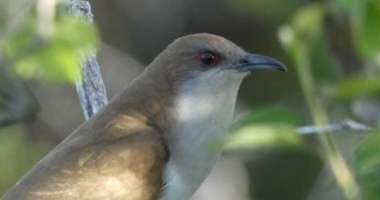Montana Audubon Science Team’s Multi-Project Field Season Kickoff

The Montana Audubon Science team has kicked off yet another busy, multi-project field season with a 4-day training session followed by several surveys on the Missouri River near Fort Benton and Loma. This summer we are continuing our partnership with the University of Montana Bird Ecology Lab (UMBEL) on the Black-billed Cuckoo Project and the overlapping Madison/Missouri River Riverine Bird Surveys Project. Since some of the project technicians will conduct surveys along nearly 400 miles of river, we spent a lot of time discussing river safety and practicing proper boating techniques in addition to the usual intensive visual and auditory bird identification training. As soon as everyone on the crew felt comfortable surveying along unpredictable river stretches, we were sent out to survey several long-term monitoring sites between Carter Ferry, Fort Benton, and between Loma (Wood Bottom) and Coal Banks.

Panorama of the Missouri River in autumn above Fort Benton, Montana
During these 5-6 hour floats down the Missouri River, we stopped at multiple established monitoring sites and recorded every bird we identified by sight and sound (the vast majority of detections are by sound alone) for 10 minutes. Carrying out these structured river surveys year after year is important because it’s the only way we can notice real, as opposed to suspected or anecdotal, population trends over time. We also carry out a comprehensive vegetation survey at every bird survey point. This allows us to monitor changes in vegetation communities within sensitive riparian systems and teaches us about habitat preferences and associations of different bird species.
Speaking of habitat preferences, this year we are also supporting University of Montana graduate student Anna Kurtin. Kurtin is greatly expanding the ongoing Black-billed Cuckoo Project in which technicians from project partners UMBEL, the Smithsonian Conservation Biology Institute, and Montana Audubon have been deploying Autonomous Recording Units (ARU). In past years we deployed ARU along some of the largest and most robust cottonwood galleries on the river because, to the best of our knowledge, cuckoos in Montana seem to be most common in this habitat. But what if we are detecting more elusive cuckoos within cottonwood galleries simply because project technicians and Montana birders pay more attention to this type of habitat? Is it possible that cuckoos are just as common in less-visited habitats in the vicinity of our large river corridors? If so, what other habitat do they prefer? Kurtin is hoping to answer these questions by deploying ARU in diverse habitats in central and eastern Montana.
Black-billed Cuckoo surveys carried out by Anna Kurtin and the project partners mentioned above start with 5 minutes of silent listening for and calling cuckoos, followed by the observer playing a series of cuckoo call recordings. Although they can be quite secretive, cuckoos are territorial, curious, and very likely to respond to a recording of a perceived competitor. After the playback, whether a cuckoo was detected or not, we secure an ARU to a tree near the survey site, and the unit then records all sounds within several hundred yards of the site at regular intervals until the beginning of September. During processing computer software isolates any recorded sounds that are similar to cuckoo calls, and project leaders and technicians make the final determination as to whether a given recording is a Black-billed Cuckoo.
We’ve already conducted several riverine bird and cuckoo surveys and deployed multiple ARUs during late May’s week of training and river floats. We will complete these surveys by mid-July and will collect the ARU at the end of the summer. We are looking forward to analyzing yet another year of field data and learning more about the state of Black-billed Cuckoos and bird populations as a whole throughout our survey areas. Stay posted for more on the Riverine Bird Surveys and Black-billed Cuckoo research, including some preliminary results, later this fall!

One of 6 Black-billed Cuckoos observed by Christian Meny and Bo Crees on an Audubon Conservation Ranching ranch in south-central Montana
A fun note about cuckoos! The Director of Conservation Ranching (ACR), Christian Meny, and Avian Specialist Bo Crees recently surveyed one of the ACR ranches in south-central Montana and were surprised to find 6 different Black-billed Cuckoos in dense thickets lining several upland coulees on the ranch. Although this was not a part of the Black-billed Cuckoo Project, it will be interesting to see if Anna Kurtin will end up finding cuckoos in similar habitats within the cuckoo study area. Stay tuned!